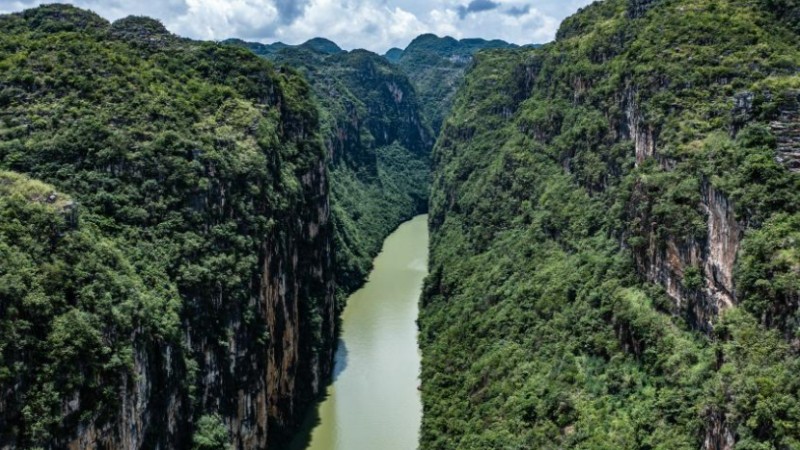Chengdu Universiade | Universiade steps up Chengdu's building of green city
CHENGDU, Aug. 3 (Xinhua) -- When the participants of Chengdu Universiade have meals in the event's venues, they use food containers with green labels.
"All the containers are made of degradable and recyclable materials," says Fan Ye, a volunteer at the waterpolo venue.
Chengdu, the capital city of China's southwest Sichuan province, has stepped up its building of a green city while hosting the FISU World University Games.
RECYCLABLE PHILOSOPHY
When the participants of Chengdu Universiade receive drinking water, they can see a special area on every bottle for marking or signature.
Chinese water polo athlete Wang Beiyi likes to sign on the bottle before drinking up the water. What's more, he likes to put the empty bottle into a special facility in the Universiade Village, named "low carbon cube".
"The cube will give me some low carbon points. I can pay for some gifts by the points," Wang said.
"You can see the low carbon cubes not only in the Universiade Village, but also all the competition venues. They can remind attendees to practice a low carbon lifestyle," said Fu Shijing, from the low carbon cube.
To save costs, Chengdu FISU Games organizers borrowed more than 300 seats from the main media center of the Beijing 2022 Winter Olympics.
GREEN TRANSPORT SYSTEM
American athlete Madeline Olson traveled through the Universiade Village by taking an electromobile. The mini transport system has 10 stops, helping villagers arrive at their rooms and canteen smoothly.
"To ensure the travel of the athletes in the Universiade Village, we have arranged shuttle buses from the Universiade Village to 49 competition and training venues. We make daily shuttle bus operation plans according to the athletes' competition schedules and training needs," said Yin Xin, a staff member from the Chengdu Universiade transport service center.
When the shuttle buses run on the roads of the green city, they attract people's attention by their special panda-like faces.
"We provide around 2,340 new energy buses and cars for the Chengdu Universiade transport, which fully reflects the concept of low-carbon and green," said Du Shengge, deputy director of the urban work service department of the Chengdu Universiade executive committee.
Various types of renewable energy have been widely used in the tournament. In the Longquan competition area, 50 local-made hydrogen-powered vehicles are available. A new petrol and hydrogen station was also built in Pidu District to ensure the power supply of some 100 buses.
ENERGY-SAVING CONSTRUCTIONS
Temperatures in Chengdu reach 35 degrees Celsius in summer, making it uncomfortable to spend a lot of time outside. Entering the life-service center in the Universiade Village, attendees feel cool and comfortable.
Instead of air conditioning, the building is cooled by natural ventilation using the application of "Lengxiang", a traditional Chinese building technique used since ancient times.
According to Lu Yixiu, an architect with China Southwest Architecture, compared with using air conditioning, the "Lengxiang" technique reduces the use of electricity in the building by about 7,000 kWh each year.
Besides, 13 newly-established venues for the Chengdu Universiade are all high-standard green buildings.
For instance, Xindu Xiangcheng Sports Center Natatorium, which stages basketball games, has been equipped with a rainwater-collecting system. The reserved rainwater can be used to irrigate surrounding plants, saving more than 3,000 tons of water each year.
The tennis venue features power-generation glass, which can power road signs. Some venues are installed with geothermal heat pumps to supply power for the buildings.
"We will collect typical low-carbon cases in the Chengdu Universiade and republish a report after the Games as a heritage, just like Beijing 2022 organizers did after that event," Du said, adding that measures taken in the Universiade will reduce carbon emissions by about 26,000 tons.
(Chen Jian, Dong Xiaohong, Yuan Qiuyue, Kang Jinqian and Chen Di also contributed to the story)
Photos
Related Stories
- Chengdu Universiade | China claims two taekwondo golds
- Chengdu Universiade | Feature: Self-driving of NEVs in Universiade Village wows foreign student-athletes
- Chengdu Universiade | Day 6: China strengthens lead at halfway point
- Chengdu Universiade Torch Tower lights up at night
- Tourists flock to Chengdu for leisure lifestyle
Copyright © 2023 People's Daily Online. All Rights Reserved.









